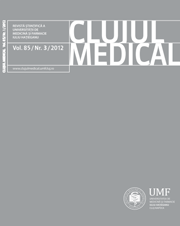Formulation of Bioadhesive Matrix Tablets with Different Concentrations of Carbopol and Sodium Carboxymethyl Cellulose Using an Experimental Design
Keywords:
bioadhesive tablets, bioadhesive polymers, experimental design, famotidineAbstract
Aims. The aim of this work was to study the effect of different combinations of three widely used bioadhesive polymers on the properies of bioadhesive matrix tablets with famotidine.
Materials and methods. To perform the study an experimental design with two factors and three levels was used. The formulation factors studied were: the percentage of Carbopol and the percentage of sodium carboxymethyl cellulose. The tablets were studied regarding their in vitro dissolution behavior, the bioadhesion, the water uptake and the erosion profile.
Results. According to the obtained results, despite the big difference between total polymer content in the tablets, the dissolution and water uptake profiles were similar between the tested formulations. Regarding the erosion profiles, the formulation with the higher amounts of polymer, in particular with higher amount of Carbopol showed a marked erosion. In terms of bioadhesiveness the combination of Carbopol and sodium carboxymethyl cellulose showed a synergic effect of bioadhesive properties with increasing concentration. Over the range of 35% to 65% of total polymer concentration the formulation factors did not have a massive impact on the properties of bioadhesive maxtrix tablets.
Conclusions. The higher the concentration of Carbopol (30%) and sodium carboxymethyl cellulose (30%) used in the formulation, the slower the release rate which is governed by diffusion through the gel layer and erosion of the matrix. The combination of Carbopol and sodium carboxymethyl cellulose used in higher concentrations also favors the bioadhesive forces of the formulations.
Downloads
Published
How to Cite
Issue
Section
License
The authors are required to transfer the copyright of the published paper to the journal. This is done by agreeing to sign the Copyright Assignment Form. Whenever the case, authors are also required to send permissions to reproduce material (such as illustrations) from the copyright holder.

The papers published in the journal are licensed under a Creative Commons Attribution-NonCommercial-NoDerivatives 4.0 International License.

